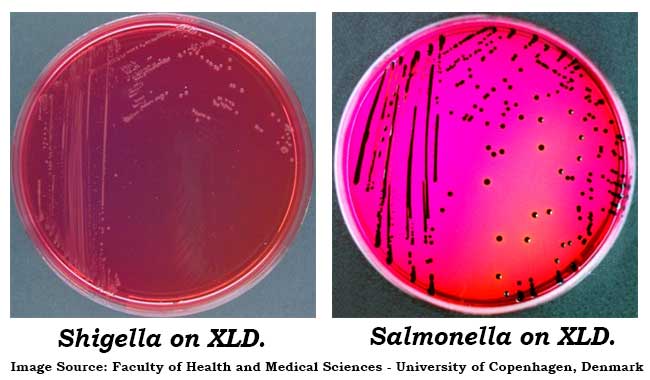Presentation on Medical Microbiology.
Introduction:
Shigella is named after the Japanese microbiologist Kiyoshi Shiga who isolated the first member of the group in 1896 from epidemic dysentery in Japan which was then called Shigella shiga and is now called as S. dysenteriae.
Shigella is an Enterobacteriaceae
Cultural characteristics
Temperature range for growth 10-40°C(Optimum temp 37 °C)
In Nutrient Agar (After overnight culture)
Viable in water for days and in ice for 1-6 months, In feces, it dies within few hour due to acidity produced by growth of coliform.
Biochemical reactions

Classification: based on biochemical and antigenic characteristics.
Taxonomy
Family Enterobacteriaceae
Virulence factors:
Clinical symptoms
Ranges from asymptomatic infection to severe bacillary dysentery
Two-stage disease: watery diarrhea changing to dysentery with frequent small stools with blood and mucus, tenesmus, cramps, fever
Early stage:
Pathogenesis
Laboratory diagnosis
Sampling: fresh stool, mucus flakes, and rectal swabs
Selenite F broth(0.4%) is used as enrichment and transport media (for 9-12 hours)
Culture media: Non-Selective Bromocresol purple lactose agar, Low selective MacConkey agar, High selective Deoxycholate citrate agar and SS agar.
Reservoir: Man only
Transmission: Faeco-oral route
Distribution: Developing country: S. flexneri
Developed country; S. sonnei
Treatment and control:
Ciprofloxacin, Fluoroquinolone, Azithromycin, Pivmecillinam, Ceftriaxone
Introduction:
Shigella is named after the Japanese microbiologist Kiyoshi Shiga who isolated the first member of the group in 1896 from epidemic dysentery in Japan which was then called Shigella shiga and is now called as S. dysenteriae.
Shigella is an Enterobacteriaceae
- Gram-negative, Non-motile
- Facultative anaerobes
- Nonspore forming
- Non-capsulated
- Non-lactose fermenting except S. sonnei.
- Catalase positive except S. dysenteriae type1 and Oxidase negative.
Cultural characteristics
Temperature range for growth 10-40°C(Optimum temp 37 °C)
In Nutrient Agar (After overnight culture)
- 2 mm in diameter, circular, convex, smooth and translucent.
- Colorless Colony except for S. sonnei (Pink colony)
- Colorless Colony
Viable in water for days and in ice for 1-6 months, In feces, it dies within few hour due to acidity produced by growth of coliform.
Biochemical reactions
- Catalase positive except dysenteriae type 1.
- Methyl red positive
- VP negative
- Urease negative
- Citrate negative
- Oxidase negative
- No production of H2S
- sonnei is a late lactose fermenter.

Classification: based on biochemical and antigenic characteristics.
- Subgroup A: S. dysenteriae: 15 serotypes:
- Subgroup B: S. flexneri: 8 serotypes.
- Subgroup C: S. boydii: 19 serotypes
- Subgroup D: S. sonnei: only one serotype
Taxonomy
Family Enterobacteriaceae
- Shigella dysenteriae: the most serious form of bacillary dysentery (Shiga toxin)
- Shigella flexneri: shigellosis in underdeveloped countries
- Shigella sonnei: shigellosis in developed countries
- Shigella boydii: Less frequently isolated from dysentery patients.
Virulence factors:
- Plasmid antigens: Effectors of plasmid transmit from the bacterial cytoplasm to epithelial cell cytoplasm of the colon.
- Invasiveness: Virulent Shigella penetrate the mucosa and epithelial cells of the colon in an uneven manner. Intracellular multiplication leads to invasion of adjacent cells, inflammation, and cell death. Cell death is probably due the to cytotoxic properties of shiga toxin that interfere with protein synthesis. The cellular death and resulting phagocytosis response by the host account for the bloody discharge of mucus and pus and shallow ulcers characteristic of the disease.
- Other toxins: It has a Shiga toxin which may be neurotoxic, cytotoxic, and enterotoxin. The enterotoxin property is responsible for watery diarrhea.
Clinical symptoms
Ranges from asymptomatic infection to severe bacillary dysentery
Two-stage disease: watery diarrhea changing to dysentery with frequent small stools with blood and mucus, tenesmus, cramps, fever
Early stage:
- Watery diarrhea attributed to the enterotoxic activity of Shiga toxin
- Fever attributed to the neurotoxic activity of toxin
- Ingestion
- Non-invasive colonization and cell multiplication
- Production of the enterotoxin by the pathogenic bacteria in the small intestine;
- Adherence to tissue invasion of the large intestine
- Typical symptoms of dysentery
- Cytotoxic activity of Shiga toxin increases severity
Pathogenesis
- Source: Man: Case or carrier.
- Mode of spread: Contaminated fingers, food, flies, fomites
- Person to person transmission
- Infective dose: 10-100 viable bacilli
- Highest concentration in stool during early/acute infection 103 to 109 viable bacilli per gram of stool
Laboratory diagnosis
Sampling: fresh stool, mucus flakes, and rectal swabs
Selenite F broth(0.4%) is used as enrichment and transport media (for 9-12 hours)
Culture media: Non-Selective Bromocresol purple lactose agar, Low selective MacConkey agar, High selective Deoxycholate citrate agar and SS agar.
Reservoir: Man only
Transmission: Faeco-oral route
Distribution: Developing country: S. flexneri
Developed country; S. sonnei
Treatment and control:
Ciprofloxacin, Fluoroquinolone, Azithromycin, Pivmecillinam, Ceftriaxone
- Preventing infected individuals from handling food
- Thoroughly washing hands after changing and disposing of an infant’s diaper
- Disinfecting surfaces handled by infected individuals
- Not allowing infected children to play in community swimming areas
- If traveling, consuming boiled or filtered water, fruits peeled by self and hot meals
- Proper storage of food
A Multimedia Presentation on Shigella
By
Chakra Bhandari
Bikram Shrestha
www.chakrapanibhandari.com.np
Amrit Science College,
Department Of Microbiology Tribhuvan University Nepal


